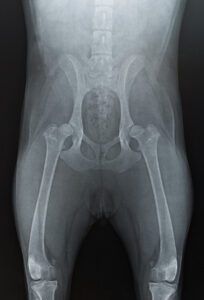Hip dysplasia in a puppy is an abnormally developed hip joint. It is very rarely caused by trauma to the puppy’s hip bone cartilage. In most cases, the puppy was born with hip dysplasia.
What Is Dog Hip Dysplasia?
The hip is a ball-and-socket joint. The head of the femur (the long bone below the hip) is the “ball” that should fit comfortably into the acetabulum, which is the concave “socket” on the pelvis. Ideally, these two areas develop, fit, and grow together, fitting neatly.
With dysplasia, the two parts don’t fit together tightly and fully. The femur head may be totally out of the socket of the acetabulum, or the acetabulum may be flattened to some extent, so it doesn’t “cup” the femoral head. In hip dysplasia, there is joint laxity that will contribute to the development of arthritis over time.
When Does Dysplasia Show Up in a Dog?
Severe cases of hip dysplasia may show up in a puppy as early as 4 months of age, but generally owners or veterinarians notice problems at 9 months to 1 year of age. Mild cases may not get diagnosed until a dog is even older, usually with clinical signs due to secondary osteoarthritis.
It can be difficult to identify a hip problem in young puppies, especially if the problem is mild. Puppies tend to move a bit galumpy, especially large and giant breeds, which tend to have the highest rates of hip problems. Some people think there is a puppy dog hip dysplasia stance, which is described as a narrow hind-leg stance, but the puppy’s gait, or movement, is a more telling sign of hip dysplasia.
How Do You Know Your Puppy Has Hip Dysplasia?
Limping is an obvious sign of dysplasia. If both rear legs are affected, however, the gait may appear normal but with a short stride. Within a litter, an affected pup may take longer to get up and get moving. He may be consistently left behind when the others take off running. His movement may appear “wobbly” or ataxic (kind of clumsy).
A puppy who tends to “bunny hop” frequently often has an orthopedic problem. (Many pups will do this occasionally but grow out of it.) You might notice that the pup does not stand square on all four feet but “off loads” weight on one hind leg. You can tell this by looking at the paws. Do they both look the same when standing on level ground? You can also see if your pup reacts the same when you go to pick up one hind leg versus the other.
Puppies with dysplasia often are less active due to soreness. An affected pup may have more trouble doing stairs than littermates. While most puppies don’t show acute pain, some will. Those pups may snap or cry if you touch or try to manipulate the painful hip joint. Astute owners may notice a difference in muscle mass between the two rear legs if only one hip is involved.
Veterinary Diagnosis of Hip Dysplasia

Credit: CatPaws | iStock
Ortolani Sign. Your veterinarian may be able to predict hip dysplasia by checking for the Ortolani Sign, which is a way for your veterinarian to grade hip laxity. This manipulation is based on a test done on newborn human babies. According to the American College of Veterinary Surgeons, “Many primary care veterinarians can perform this exam during the early age, 10 to 16 weeks, often done at vaccination or wellness exams. If the Ortolani Sign is not present, there is a false negative possibility that can be resolved by the quantitative PennHIP method.”
PennHIP radiographs. The PennHIP evaluation for puppy joint laxity can be officially done as young as 16 weeks of age. For definitive diagnosis, the PennHIP radiographs are the way to go. PennHIP requires general anesthesia or heavy sedation, some special equipment, and a certification process completed by veterinarians performing the procedure. A big advantage to this evaluation is that if joint laxity is conformed, the puppy has multiple surgical options available to minimize potential lifelong disability. Some of those surgical procedures are best done by a year of age.
OFA System. The Orthopedic Foundation for Animals, or OFA, is the best-known radiographic system for evaluating hips in dogs. This involves one film that is evaluated by three veterinary radiologists. A pup can have a preliminary report done at a year of age with a permanent evaluation done at two years of age.
Treatment for Puppy Hip Dysplasia
Owners of puppies with hip dysplasia have four surgical treatment options. These procedures should be done by board-certified veterinary surgeons as these are complicated orthopedic procedures. The future activity level of the puppy will vary with the procedure. Strict post-op care and rehabilitation will be important.
Mild cases of hip dysplasia. Luckily, most dogs with mild hip dysplasia do not require surgery for good quality of life. Diet and nutrition are extremely important. Puppies should not be allowed to get overweight and should be on a balanced diet suitable for puppies (with special consideration for large and giant breed puppies). Slow, steady growth is ideal. Moderate exercise is important as well. This means daily leash walking and low-impact exercise like swimming. You want to keep the affected joints from getting stiff from disuse but not overly strain them.
Rehab helps. If your veterinary clinic has a rehab department, it is ideal to work with them to come up with a program to keep your pup fit but not overstressed. That might involve exercises to do at home, use of a treadmill (dry or underwater), and a walking regimen. Avoid sports like leaping after a flying disc or agility.
Maybe to Supplements. Cartilage protection and joint supplements don’t have extensive clinical proof but, anecdotally, many of them help keep dogs with arthritis comfortable. Discuss which ones make sense for your pup with your veterinarian. Be aware that some dog foods already contain joint supplements, but the amounts included are rarely enough to be therapeutic.
NSAIDs for pain. For days when your pup is in pain, NSAIDS (non-steroidal anti-inflammatory drugs) may be needed for good quality of life.
Prevention of Hip Dysplasia
How can you avoid or prevent hip dysplasia? Start by getting a puppy with an extensive health pedigree for good hips—ask the breeder. This means his parents had hip evaluations, as well as aunts, uncles, grandparents, etc. While this is not a guarantee of good hips, since it is a polygenic trait with environmental influences, it is a great start.
Keep your puppy slim while growing up. Avoid high joint-stress exercise. That means no long runs, minimal trips up and down lots of steps, and no or minimal jumping while joints are still developing and growth plates have not closed.







After the recent loss of my beloved Golden, I’m starting to research getting a male Golden Retriever puppy in about 4-5 months. One breeder told me that, to help prevent hip dysplasia, she requires no sterilization of male pups until at least 2 years of age since their growth plates are not done developing/closing until that age. I had always heard after one year of age was okay but she said that is “old information”.
Since I would like to train my new pup for therapy dog services (nursing homes and children’s hospital visits), I know that that would require he be altered before 2 years of age, but I won’t if it means I’d be putting him at higher risk of dysplasia. Does anyone have thoughts about this?